
Map of the Near East,6000-1000 BC, Wikimedia
(To read the detail, click on the map)
The Gods Man Created
Mesopotamia and Egypt
Mesopotamia
6500
BC-700 AD
In the 4th milenium, in the city states of Mesopotamia man invented
the first systematic religion: a patriarchal polytheistic Hierarchy
of Gods adapted to each city, a Cosmology with an Underworld, and a
Creation Myth. To an astonishing degree they would form the basis for
Near Eastern and Western European religions to come: Judaism,
Christianity, Islam, and their variations.
Why the people in this
region should have invented these three particular belief systems is
an anthropological and sociological question that is difficult to
answer. It is not the advent of agriculture (“Fertile Crescent”)
as has been argued, because western and Far Eastern agricultural
societies (Proto-Europe, Indus Valley, China) for 4000 years stuck to
matriarchal paradigms, and eventually India and China developed their
own religions independently.

Map
of the Near East,6000-1000 BC, Wikimedia
(To
read the
detail, click on the map)
Sumer and Akkad
6500-2000
BC
Sumer was first permanently settled between 6500 and 5000 BC by
agrarian Proto-Indo-European tribes from Anatolia, who are generally
refered to as "Ubaidians". Sumer would last from the 5th to
the 3rd millennia BC, ending with the downfall of the Third Dynasty
of Ur around 2004 BC before the rise of Babylonia in the 18th century
BC. Ubaid culture developed irrigation, large village settlements,
and built the first temples in Mesopotamia.
During the 4th
millennium BC Sumerian civilization took on a reconizable form (Uruk
period). During the 3rd millennium BC a close cultural symbiosis
developed between the Sumerians and the local pastoral Semitic
Akkadians, which included widespread bilingualism. The influence of
Sumerian on Akkadian (and vice versa) is evident in all
linguistic areas, from lexical borrowing on a large scale, to
syntactic, morphological, and phonological convergence. The Sumerian
city of Eridu, on the coast of the Persian Gulf, was the world's
first city, where three separate cultures fused - that of Ubaidian
farmers, living in mud-brick huts and practicing irrigation; that of
mobile nomadic Semitic pastoralists living in black tents and
following herds of sheep and goats; and that of fisher folk, living
in reed huts in the marshlands. The city of Ur (2600-1940 BC) became
the center of the Sumerian kingdoms with a luxurious culture and
fantastic tombs of its kings (2560 BC).
The Royal Tombs of Ur
2500-2600
BC
The Royal Tombs were excavated by Sir Charles Leonhard Woolley (1880-1960) between 1922 and 1936. Their treasures are the non-plus-ultra of Mestopotamian art. Not to disturb their beauty I will spare you the gory details of hundreds of attendants who were allowed to follow their kings and queens into the hereafter. See the excellent coverage in the Sumerian Shakespeare.
|
|
|
|
|
Treasures from the Royal Tombs, Ur, 2600 BC, British Museum, London
|
|
|
One of the more enigmatic objects found in the Royal Tombs is a box (22 cm high x 50 cm long), heavily encrusted with a lapislazuli inlay. Leonard Woolley, its excavator, called it the “Standard of Ur” that was carried in front of the advancing army in battle. For that it is too heavy, precious, and vulnerable. Various equally unsatisfactory explanations of its use have been proposed. - Could it have been the 'ark of the covenant' with their God, a predecessor of the “Ark of theCovenant” in which the Israelites (1400 BC) carried Moses' “Ten Commandments” in their processions?
From 2270 to 2083 BC Sumer was ruled by Semitic-speaking Akkadian kings (Akkadian Empire), but Sumerian continued as a sacred language. Native Sumerian rule re-emerged for about a century in the Third Dynasty of Ur during the late 21st century BC, but the Akkadian language also remained in use.
The crucial development was the invention of the Cuneiform script
(2400 BC) by the Sumerians - For the first time there exists a
written History!
This would not happen in the Western
Proto-European areas until around 900 BC, when the Greeks created a
written – alphabetical – script from Phoenician, the sucessor to
the Canaans. Around that time proto-Hebrew developed from the same
Western-Semitic source.
The Timeline
of Mesopotamia by the British Museum gives a beautiful overview
of the historical events with pictures and explanations. The website
also has timelines for other subjects of interest. - Another
exhaustive, highly recommended, illustrated tour-de-force of
Sumerian culture and artifacts is found under the title “A
Sumerian Shakespeare”
The First Organized Religion
Mesopotamian religion combined the religious beliefs and practices of the Indo-European Sumerians – who had immigrated from Anatolia – and the indigenous, Semitic Akkadians. Later it spread to the remaining Semitic peoples: Assyrians (1200 BC), Babylonians and Chaldeans (600 BC) living in Greater Mesopotamia. Combining the creative resources of two different mentalities and several languages, it dominated Mesopotamia for a period of 4,200 years from the fourth millennium BC to the 7th century AD in Assyria!

Sumerian
Devotees from Eshnunna
(Tell Asmar), 2700 BC
Mesopotamian religion was polytheistic, thereby accepting the existence of many different deities, both male and female, though it was also henotheistic, with certain gods being viewed as superior to others by their specific devotees. These devotees were often from a particular city or city-state that held that deity as its patron deity. The god Enki was associated with the city of Eridu, and the god Marduk with Babylon. Though the full number of gods and goddesses found in Mesopotamia is not known, K. Tallqvist, in his Akkadische Götterepitheta (1938) counted around 2400!
Due to the many city states, each with their own gods, it is impossible to give a short description of the Mesopotamian Pantheon. The following table shows the names and relationships between the most important deities.
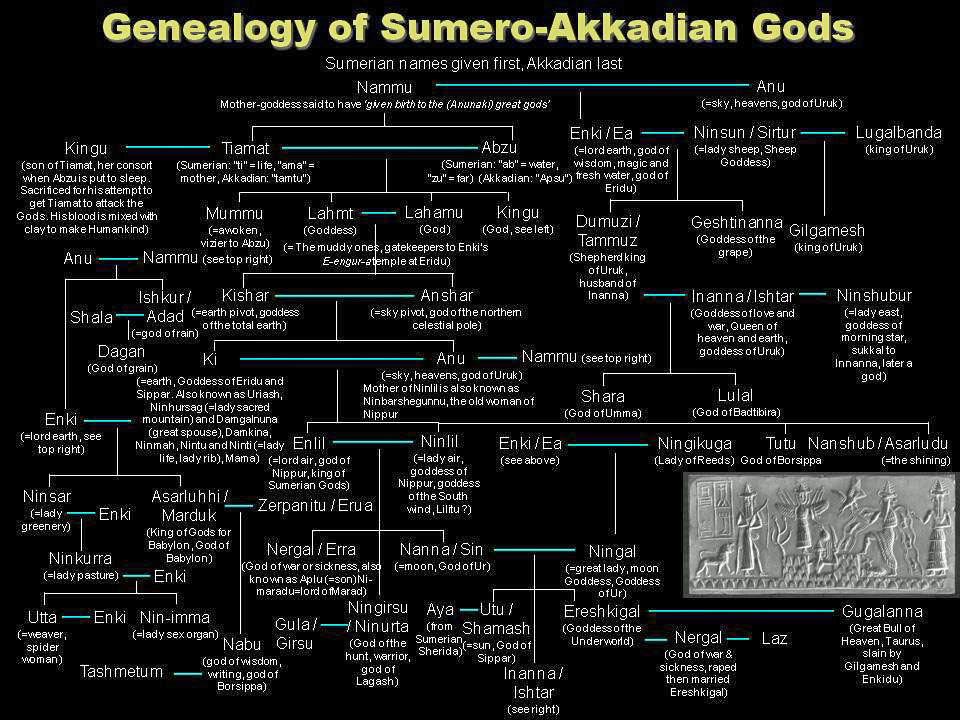
Early Mesopotamian Gods, Wikipedia
The Mesopotamian gods were anthropomorphic. They often acted like humans, requiring food and drink, as well as consuming alcohol and subsequently suffering the effects of drunkenness, but were thought to have a higher degree of perfection than common men. They were more powerful, all-seeing and all-knowing, unfathomable, and, above all, immortal. One of their prominent features was a terrifying brightness (melammu) which surrounded them, producing an immediate reaction of awe and reverence among men. The gods were not viewed mystically, but were instead seen as high-up masters who had to be obeyed and feared, as opposed to loved and adored.
Sumerian Myths
Mesopotamian civilisation produced a wealth of elaborate myths in epic form that lived on in subsequent cultures to our days. Two of the best known are summarized below.
Gilgamesh Epic
Sumer-Uruk/Akkadia
2600
BC
Enkidu assists Gilgamesh, the King of Uruk in defeating and killing Humbaba, the guardian monster of the Cedar Forest. Afterwards, he again assists Gilgamesh in slaying Gugalanna the Bull of Heaven, which the gods had sent to kill Gilgamesh as a reprisal for spurning the goddess Ishtar's affections while enumerating the misfortunes that befell her former lovers. Ishtar demands that the pair pay for the bull's destruction. Shamash argues to the other gods to spare both of them, but could only save Gilgamesh. The gods pass judgment that Enkidu had no justification for fighting the Bull of Heaven and was interfering with their will. Enkidu then is overcome by a severe illness. Near death, he has visions of a gloomy afterlife, and curses the trapper and Shamhat for civilizing him. He retracts his curse on Shamhat, however, after Shamash scolds him, reminding him that it was Shamhat who taught him the pleasures of civilization, and ultimately, made Gilgamesh a Sumerian Demi-God. Wikipedia
Creation Myth
Babylonian
1600
BC
The earliest record of the Sumerian creation and flood is found on a single fragmentary tablet excavated in Nippur, sometimes called the Eridu Genesis. It is written in Sumerian and dated to around 1600 BC during the first Babylonian dynasty, where the language of writing and administration was still Sumerian.
Where the tablet picks up, the gods An, Enlil, Enki and Ninhursanga
create the black-headed people and create comfortable
conditions for the animals to live and procreate. Then kingship
descends from heaven and the first cities are founded: Eridu,
Bad-tibira, Larsa, Sippar, and Shuruppak.
After a missing section
in the tablet, we learn that the gods have decided not to save
mankind from an impending flood. Zi-ud-sura, the king and gudug
priest, learns of this. In the later Akkadian version, Ea, or Enki in
Sumerian, the god of the waters, warns the hero (Atra-hasis in this
case) and gives him instructions for the ark. This is missing in the
Sumerian fragment, but a mention of Enki taking counsel with himself
suggests that this is Enki's role in the Sumerian version as
well.
When the tablet resumes it is describing the flood. A
terrible storm rocks the huge boat for seven days and seven nights,
then Utu (the Sun god) appears and Zi-ud-sura creates an opening in
the boat, prostrates himself, and sacrifices oxen and sheep.
After
another break the text resumes: the flood is apparently over, the
animals disembark and Zi-ud-sura prostrates himself before An
(sky-god) and Enlil (chief of the gods), who give him eternal life
and take him to dwell in Dilmun
for "preserving the animals and the seed of mankind". The
remainder of the poem is lost. Wikipedia
Cylinder
Seals
Sumer-Babylon
3500-1200
BC
Around 3500 BC Mesopotamian Cylinder Seals begin to appear; another unique invention of the Sumer-Akkadian culture. Used as personal “chops” on official clay-tablet documents, they show the myths of the Mesopotamian Gods in artistically sophisticated and often enigmatic scenes. Thousands have been found as far away as the Indus Valley and early Greece. Unfortunately their decipherment is difficult – inpart due to modern astrology having adopted the images to support their intuitive attempts at ad hoc interpretations: the seven balls for example, are not the seven planets but the Pleiades. Sumerian astromoners knew only 5 planets, etc. - I have tried to find selfconstistent readings in the internet – burt much remains a mystery.
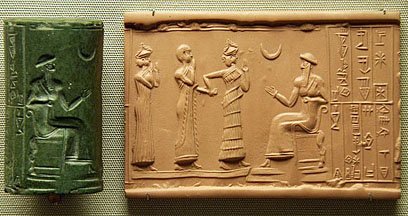
A
steatite cylinder seal and its imprint in clay,
The seal's owner
introduced by Ningal (Moon) to King Ur-Nammu
(early 21st cent BC)
photo crystalinks
|
|
|
|
|
|
|
|
|
|
|
|
|
|
|
Egypt
4000-30
BC
The
Egyptian Gods
The principle Deities of the Egyptian Pantheon – there are more than 1400 – were by 2000 BC well established, their characteristics defined. Apparently the upper class of Egyptian society did not engage in myth-making like the Sumerians and Akkadians, and the beliefs of the lower classes never reached the pharaohs. Rituals appear to have preceeded the formation of myths, and every major Egyption center developed their own myth ascribed to their royal favoritr deity, for example the Creation of the World.

Line-up
of the principle Egyptian Gods from costumessupercenter!
For
an annotated list see egyptartsite
The beliefs and rituals surrounding these gods formed the core of ancient Egyptian religion, which emerged along with them some time in prehistory. Deities were not mystical entities, they represented natural forces and phenomena, and the Egyptians supported and appeased them through offerings and rituals so that these forces would continue to function according to Maat, the divine order. After the founding of the Egyptian state around 3100 BC, the authority to perform these rituals was the pharaoh, who claimed to be the gods' representative and managed the temples, where the rituals were carried out by a cast of priests and priestesses. The third group of influential bureaucrats were the scribes, only an estimated 1% of the people could read and write the hieroglyphic script (3200/2600 BC).
At different times, various gods were said to hold the highest position in divine society, including the solar deity Ra (Rê), the mysterious god Amun, and the mother goddess Isis. The highest deity was usually credited with the creation of the world and often connected with the life-giving power of the sun. The Egyptians never abandoned their original polytheistic view of the world, except for a period of 27-years during the reign of Amenophis-Akhenaten (1353-1336 BC), when official religion focused exclusively on the impersonal sun god Aten.
The first written evidence of deities in Egypt comes from the Early Dynastic Period (3100–2686 BC). Deities must have emerged sometime in the preceding Predynastic Period (before 3100 BC) and have grown out of prehistoric religious rituals. Predynastic artwork depicts a variety of animal and human figures, but in most cases there is not enough evidence to say whether the images are connected with deities.
|
|
|
|
Images of the Gods from the Tomb of Prince Khaemwaset (VdR 44), Thebes, Valley of the Queens, Photos Dalbera
The types of phenomena the Gods represented included physical places and objects as well as abstract concepts and forces. The god Shu was the deification of all the world's air; the goddess Meretseger oversaw a limited region of the earth, the Theban Necropolis; and the god Sia (Saa) personified the abstract notion of perception. Major gods often had many roles and were involved in several types of phenomena. For instance,Thoth was a god of the moon. Because the moon was essential to the reckoning of the calendar, he was also in charge of timekeeping, calculation, writing, and the scribes who performed these activities in Egyptian society. Gods could share the same role in nature; Ra, Aten, Khepri, Horus, and other deities acted as sun gods. Despite their diverse functions, most gods had an overarching role in common: maintaining maat, the universal order that was a central principle of Egyptian religion and was itself personified as a goddess. No deity was truly immortal; instead the gods periodically died passing through the Underworld (duat) and were reborn by repeating the events of creation, thus renewing the whole world. Wikipedia
The Egyptians had a complex conception of the human soul being made up of five parts, ib (heart), sheut (shadow), ren (given name), ba ( power, psyche), ka (vital essence, spirit), and after death akh ('ghost'). The gods were composed of these same elements. However, Gods could assume many bas and kas representing different aspects of the god's nature. Everything in existence was said to be one of the kas of Aten (Horus)the creator god, who originally contained all things within himself, and one deity could be called the ba of another, meaning that the first god is a manifestation of the other's power. Divine body parts could also act as separate deities, like the Eye of Ra and the Hand of Aten, both of which were personified as goddesses.
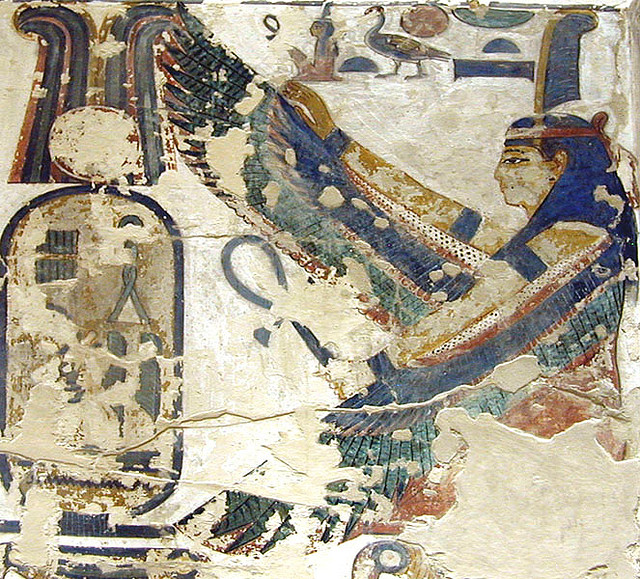
Winged
Goddess Maat, Tomb of pharoh Sethi I (cartouche!), Thebes, Valley of
the Kings (1294-1279 BC)
photo Dalbera
The earliest surviving records indicating that Maat
is the norm for nature and society, in this world and the next, were
recorded during the Old Kingdom, the earliest substantial surviving
examples being found in the Pyramid
Texts of Unas (2375 -2345 BC). Later, as a goddess in other
traditions of the Egyptian pantheon, where most goddesses were paired
with a male aspect, her masculine counterpart was Thoth and their
attributes are the same. After the rise of Ra they were depicted
together in the Solar Barque.
After her role in creation and
continuously preventing the universe from returning to chaos, her
primary role in Egyptian mythology dealt with the weighing of souls
that took place in the underworld, Duat.
Her feather was the measure that determined whether the souls
(considered to reside in the heart) of the departed would reach the
paradise of afterlife successfully. Pharaohs are often depicted with
the emblems of Maat to emphasise their role in upholding the laws of
the Creator. Wikipedia
Egyptian Myths
Few complete stories appear in Egyptian mythological sources. These sources often contain nothing more than allusions to the events to which they relate, and texts that contain actual narratives tell only portions of a larger story. Thus, for any given myth the Egyptians may have had only the general outlines of a story, from which fragments describing particular incidents were drawn. Moreover, the gods are not well-defined characters, and the motivations for their sometimes inconsistent actions are rarely given. Egyptian myths are not, therefore, fully developed tales. Their importance lay in their underlying meaning, not their characteristics as stories. Instead of coalescing into lengthy, fixed narratives, they remained highly flexible and non-dogmatic. Wikipedia
The Myth of Shu, Nut, and
Geb
The following is a late example of the more or
less general story of perptual creation
(Heliopolis)
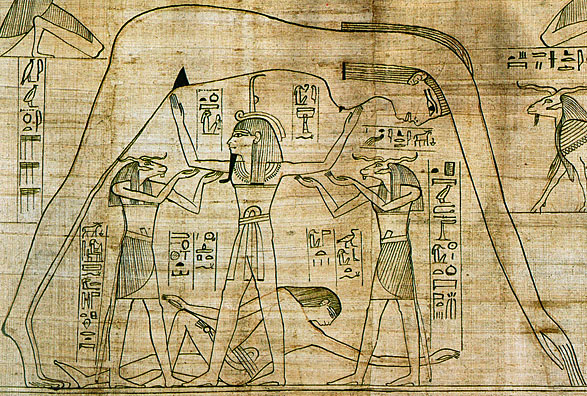
Gods
Shu and Khnum (twice) holding up Nut the Night-Sky above her
exhausted brother Geb, the Earth,
from the Greenfield
Papyrus, a version of the “Book of theDead”, 950 BC, photo
Wikimedia
The
central figure is Shu
("emptiness" and "he who rises up"), who was one
of the primordial gods in Egyptian mythology, a personification of
air. He was created by Ra
(Rê), his father and Iusaaset,
his mother (Heliopolis version). With his sister Tefnut
(moisture), Shu was the father of Geb
the Earth and Nut, the sky goddess, whom he is holding over the Earth
(Geb), separating the two from continuously copulating. Shu's
grandchildren (through Geb and Nut) are Osiris,
Isis, Set
and Nephthys, the
gods of the Underworld. His great-grandsons are Horus
and Anubis.
Khnum,
the third aspect of Ra(Rê), is the god of rebirth, creation and the
evening sun. Originally he was the god of the source of the Nile
River. Since the annual flooding of the Nile brought silt and clay,
and its water brought life to its surroundings, he was thought to be
the creator of the bodies of human children, which he made at a
potter's wheel, from clay, and placed in their mothers' wombs.
Nut
was the goddess of the sky in the Ennead of Egyptian mythology. She
was seen as a star-covered nude woman arching over the earth, or as a
cow. Nut is a daughter of Shu and Tefnut.
She was Geb's sister. She is considered one of the oldest deities
among the Egyptian pantheon, with her origin being found in the
creation story of Heliopolis. She was originally the goddess of the
nighttime sky, but eventually became referred to as simply the sky
goddess. Her headdress was the hieroglyphic of part of her name, a
pot, which may also symbolize the uterus. Mostly depicted in nude
human form, Nut was also sometimes depicted in the form of a cow
whose great body formed the sky and heavens, as a sycamore (Tree of
Life), or as a giant sow, suckling many piglets (representing the
stars).
The Egyptian Book of the
Dead
1550-50 BC
The Greenfield Papyrus, which the above image was taken from, is one of the many versions of the “Book of the Dead”. The Book of the Dead is an ancient Egyptian funerary text, used from the beginning of the New Kingdom (around 1550 BC) to Ptolemaic times around 50 BC. The Egyptian name for the text was "Book of Coming Forth by Day", or the "Book of emerging forth into Light". The text consists of a number of "magic spells" intended to assist a dead person's journey through the Duat, or underworld, and into the afterlife. Some of the spells date to the 3rd millennium BC. Other spells were composed later in Egyptian history. The Book of the Dead was placed in the coffin or burial chamber of the deceased.
There was no single or canonical Book of the Dead. The surviving papyri contain a varying selection of religious and magical texts and vary considerably in their illustration. Some people seem to have commissioned their own copies of the Book of the Dead, perhaps choosing the spells they thought most vital in their own progression to the afterlife. The Book of the Dead was most commonly written in hieroglyphic or hieratic script on a lon papyrus scroll, and often illustrated with vignettes depicting the deceased and their journey into the afterlife.
The Ani Papyrus, Thebes
1240
BC
One of the most spendid Book of the Dead is the Papyrus of Pharaoh Ani of Thebes at the British Museum.
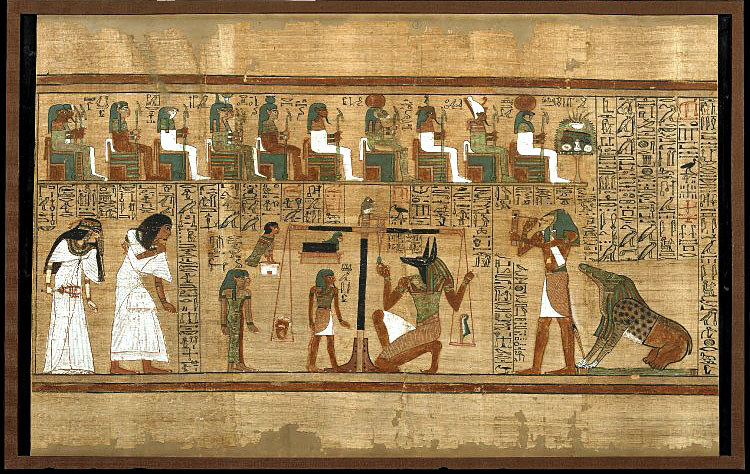
Weighing
of the Heart, Book of the Dead, Ani Papyrus, 1240 BC
Ani's Judgment: the scene is the Hall of Judgment. Centrally
placed is a balance, holding in its two pans Ani's heart (on the
left) and a feather (on the right) representing Maat, the divine
personification of truth and order. The crossbar of the balance hangs
from a feather-shaped peg attached to the upright support, on the top
of which squats a small baboon. This creature is a form of the god
Thoth, who acts in a different form and with a different duty
elsewhere in this "trial". The god Anubis, here shown as a
jackal-headed, human-bodied, kneeling deity, described as "he
who is in the place of embalming," holds the cord of the
right-hand pan, and steadies the plumb bob of the balance. To the
right of the balance stands Thoth, here in human form with ibis head;
he is the scribe of the gods, and he holds a scribe's palette and a
reed brush, ready to note down the results of Ani's interrogation. On
a mat behind Thoth sits a monster ready to spring forward to consume
Ani's heart if he fails to pass the test. This creature has the head
of a crocodile, the forepart of a lion, and the hindquarters of a
hippopotamus.
At the top of the scene the great gods of the
Egyptian Underworld are shown, formally seated on thrones, waiting to
deliver judgment: Ra-Horakhty, Atum, Shu, Tefnut, Geb, Nut, Isis and
Nephthys, Horus and Hathor, joined by gods personifying the divine
word (Hu) and perception (Sia). Other deities observe the
proceedings: to the left of the balance, Shay (fate) and, strangely,
two birth goddesses, Renenutet and Meskhenet. Ani's soul or 'ba'
bird, which will allow him freedom of movement in and out of the tomb
after death, perches on a shrine-shaped building, ready to be
released if judgment is given in Ani's favor. Into this formidable
gathering comes Ani, accompanied by his wife Tutu. They enter from
the left, bending forward in proper humility, and Ani mutters the
words of Spell 30B of the 'Book of the Dead', which are addressed to
his heart in the balance. All, it seems, goes well for Ani; he has
qualified for the Afterlife.
Text and photo British
Museum
Interestingly, the “Negative Confessions” of the heart are the prototype of Moses' “Ten Commandments”.
Funerary Stela of
Deniuenkhons
950-900 BC
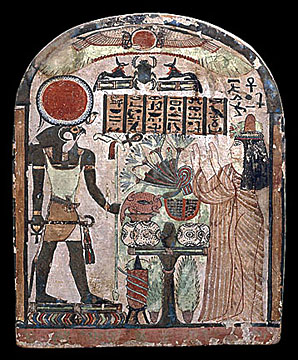
Wooden
funerary stela of Deniuenkhons, Thebes, 950-900 BC
Non-royal deceased had simpler memorials: This stela was made for a
woman named Deniuenkhonsu, a musician of Amun and the wife of
Ankhkhonsu. Deniuenkhonsu is depicted standing by a heaped offering
table, raising her hands in adoration. She wears a long, full wig
embellished with a floral fillet, a perfume cone, and lotuses. Her
voluminous pleated robe is sheer enough to reveal the flesh creases
on her belly and her rather plump hips and thighs.
Deniuenkhonsu
worships a falcon-headed god named Ra-Horakhty-Atum, a composite or
synthesis of all the main solar gods. The all-inclusiveness of this
figure is borne out by his regalia: in addition to the
cobra-encircled sun disk on his head and the 'ankh' sign in one hand,
he holds a crook and flail, usually associated with Osiris, and the
was scepter in his other hand is crowned by the feather of Maat and
another 'ankh'. Solar imagery dominates the arch of the stela. Under
a blue border representing the sky, the winged sun disk, propelled by
the scarab beetle, rises from his nocturnal travels in the
Underworld, symbolized by two figures of the jackal god, Anubis. The
offerings include lotuses; a plucked, eviscerated fowl; a bowl of
grapes (?); round, decorated loaves of bread; and, beneath the table,
two stalks of cos lettuce and a beer jar set in a stand and wound
with a lotus stem. The lower border of the stela is a reddish strip
lined with a row of little green plants. Since red and pink were used
to represent desert land, in contrast to the black earth of the Nile
Valley, this must represent a plant-bedecked strip of desert.
Text
and photo British
Museum
Thebes, The Spendor of the Royal Necropolis
1550-1070
BC
Valleys of the Kings and Queens
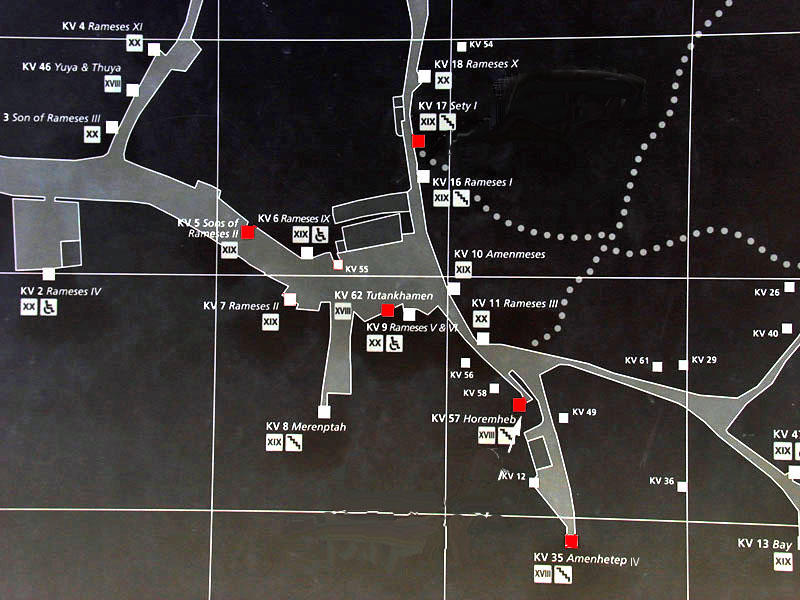
Map
of the Royal-Tombs in the Valley of the Kings
red: tombs selected
here
Amenhotep IV better known as
Akhenaten and Queen Nefertiti,
KV 35(?)
Reigned 1353-1336
BC
Amarna
(City of Akhetaten)
Akhenaten, born Amenhotep IV, ruled for 17 years and died perhaps in 1336 BC or 1334 BC. He is noted for abandoning traditional Egyptian polytheism and introducing worship centered on the Aten, which is occasionally described as monotheistic or henotheistic..
He moved the capital to Akhetaten. The ruins of Akhetaten. now commonly called Amarna, lie 400 km north of Thebes and south of Memphis. Eventually after Akhenaten's and Nefertiti's death this capital was abandoned by Tutankhamun. It survived several years before being destroyed on Horemheb's orders.
Queen Nefertiti, the daughter of Ay, married Akhenaten when he was still Amenhotep IV. Her role in daily life at the court soon extended from Great Royal Wife to that of a co-regent. It is also possible that she may have ruled Egypt in her own right as pharaoh, Neferneferuaten.
|
|
|
|
During Akhenaten's reign, royal portraiture underwent dramatic
changes. Sculptures of Akhenaten deviate from conventional portrayal
of royalty. Akhenaten is depicted in an androgynous and highly
stylized manner, with large thighs, a slim torso, drooping belly,
full lips, and a long neck and nose. He is almost always shown with
his Great Qeen Nefertiti surrounded by their two daughters.
The
tomb of Akhenaten and Nefertiti was probably originally in Amarna,
but both were later moved to the Valley of the Kings (KV 35?). The
tomb and the identities of its mummies are still disputed.
Tomb of Tutankhamun, KV 62
Reigned 1336-1327 BC
Tutankhamun was born 'Tutankhaten' during the Amarna
period, probably at the capital Akhetaten (Tell el-Amarna). The
identity of his parents is disputed. Newer DNA tests show that
Tutankhamun's mother was the sister of Akhenaten. Princess Nebetah or
Beketaten are considered candidates. The boy was a royal prince and
ascended to the throne at the age of about eight years. Tutankhamun
married his half-sister Ankhesenpaaten, daughter of Akhenaten and
Nefertiti. Tutankhamun moved his capital back to Memphis.
Analysis
of Tutankhamun's mummy suggests that he was around seventeen years
old when he died. The cause of his death is a mystery. When the young
king died unexpectedly, possibly in a hunting accident or due to
inherited complications, he was buried in the Valley of the Kings in
what was apparently intended as a non-royal tomb (KV 62). This tiny
tomb was discovered almost intact by Howard Carter in 1922.

Replica
of the Original Tomb of Tutankhamun
|
|
|
|
|
Tomb of Horemheb, KV57
Reigned
1327-1292
BC
The last two pharaohs of the eighteenth dynasty - Ay and Horemheb - became rulers from the ranks of officials in the royal court, although Ay may have married the widow of Tutankhamun in order to obtain power, she did not live long afterward. Ay's reign was short. His successor was Horemheb, who had been a scribe and general in the administration of Akhtenaten and may have been intended as his successor by the childless Tutankhamun. Horemheb may have taken the throne away from Ay in a coup. After the death of Ay, Horemheb assumed the throne. A commoner, he had served as vizier to both Tutankhamun and Ay. Horemheb instigated a policy of damnatio memoriae, against everyone associated with the Amarna period. He was married to Nefertiti's sister, Mutnodjmet, who died in child birth. With no heir, he appointed his own vizier, Paramessu as his successor. Paramessu, who under the name Ramesses I
ascended the throne in 1292 BC and was the first pharaoh
of the Nineteenth Dynasty.
Notwithstanding Horemheb's tomb is a
wonder of traditional-style painting.
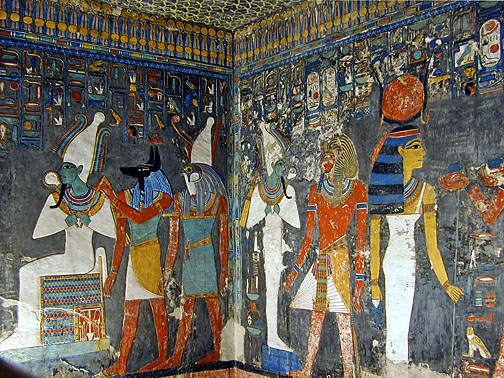
Horemheb's
Burial Chamber, the Gods of the Underworld greeting the
pharoh:
Osiris,
Anubis, Horus
– Osiris, Tefnut
the Lion-headed, Hathor
|
|
Tomb of Seti I, KV 17
Reigned
1295-1279 BC
Seti I was the second pharaoh of
the New Kingdom-Nineteenth Dynasty of Egypt, the son of Ramses I and
Queen Sitre, and the father of Ramses II. He restored the Egyptian
empire, and would be considered a great king, if he had not been
overshadowed by his son Ramses II, the Great.
His tomb in the
Valley of the Kings is an elaborate affair, although some of its
chambers remained unfinished. Photos by Dalbera
|
|
|
|
|
|
|
Tomb of Ramses II the Great
and Nefertari, KV 5 and
QV 66
Reigned 1279-1213
BC
Ramses II was
appointed Prince Regent by his father Seti I at age fourteen. He is
believed to have taken the throne in his late teens and is known to
have ruled Egypt from 1279 BC to 1213 BC for 66 years. He is regarded
as the greatest, most celebrated, and most powerful pharaoh of the
Egyptian Empire.
Ramses II was originally buried in the tomb KV7
in the Valley of the Kings but, because of looting, priests later
transferred the body to a holding area, re-wrapped it, and placed it
inside the tomb of queen Inhapy. Seventy-two hours later it was again
moved, to the tomb of the high priest Pinudjem II. All of this is
recorded in hieroglyphics on the linen covering the body. His mummy
is today in Cairo's Egyptian Museum. The mummy is known, his tomb
seemed lost – or robbed empty.
Tomb KV 5 is a subterranean, rock-cut tomb with more than 130 chambers in the Valley of the Kings. It belonged to the sons of Ramses II. Though KV 5 was partially excavated as early as 1825, its true extent was discovered only recently by Kent R. Weeks and his exploration team in 1995. The tomb is now known to be the largest in the Valley of the Kings. Weeks' discovery is widely considered the most dramatic in the valley since the discovery of the tomb of Tutankhamun in 1922. Exept for a tentative plan of the tomb no photos of its decorations are available in the internet. His wife's, Queen Nefertari's tomb QV 66 is located in the adjacent Valley of the Queens. The following photos, except for Ramses II's mummy, are from Nefertari's tomb QV 66.
|
|
|
|
|
|
|
|
|
|
The paintings found within her tomb QV 66 are the best preserved and
most detailed source of the ancient Egyptian’s journey towards the
afterlife. The tomb features several extracts from the Book of the
Dead and tells of all the ceremonies and tests taking place from the
death of Nefertari up until the end of her journey, depicted on the
door of her burial chamber, in which Nefertari is reborn and emerges
from the eastern horizon as a sun disc, forever immortalized in
victory over the world of darkness.
The details of the ceremonies
concerning her afterlife also tell us much about the duties and roles
of many major and minor gods during the reign of the 19th Dynasty in
the New Kingdom. Gods mentioned on the tomb walls include Isis,
Osiris, Anubis, Hathor, Neith, Serket, Ma'at, Wadjet, Nekhbet,
Amunet, Ra and Nephthys.